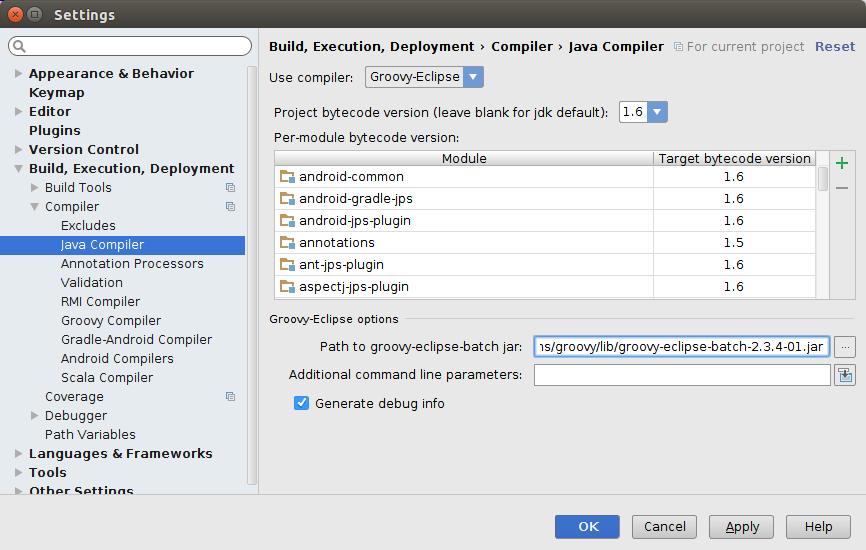IntelliJ IDEA
IntelliJ IDEA – the Leading IDE for Professional Development in Java and Kotlin
Faster Groovy Compilation in IntelliJ IDEA 14.1
Compiling Groovy code is typically slower than compiling Java code, but in 14.1 we took a swing at speeding it up.
First, we’re now supporting Groovy-Eclipse compiler that handles Java and Groovy simultaneously, which brings a noticeable performance gain. So, if you’re compiling your projects in Eclipse, you might want to give this new integration a try. Just go to the Java Compiler settings, select Groovy-Eclipse, and point to the groovy-eclipse-batch.jar. Remember that is should be the same version as your Groovy distribution.
Even if you’re not into using the Eclipse compiler, you will notice improved performance, because we’ve optimized the way IntelliJ IDEA invokes groovyc. We’ve seen about 2-3 times faster Groovy compilation with its own sources (where many tests are written in Groovy).
Here are some technical details.
For years the following had been IntelliJ IDEA’s routine for handling modules that contain Groovy files:
- Run external groovyc process to generate Java stubs from Groovy files.
- Run Java compiler (in-process) and compile all the Java files in the module, along with the generated stubs, so that references from Java to Groovy code resolve without errors.
- Run another external groovyc process to generate actual non-stub code from the Groovy sources.
Well, this isn’t the very best scenario: creating processes takes time, and each of them will subsequently need to load all the Groovy compiler classes along with project itself and library classes to be able to resolve references. And the icing on the cake is that the Groovy files are actually parsed twice in each of the processes: first for the stub generation, and then for actual compilation.
Unlike Eclipse developers, we don’t have the luxury of our own compiler and cannot directly integrate it with Groovy. IntelliJ IDEA has to be able to work with just any Java compiler, be it javac, ecj or aspectj, and with any version of Groovy too.
We probably could not do without the stub generation. Moreover, our compiler architecture suggests that Groovy and Java compilation be performed in different subsequent steps, which is not compatible with the groovyc API for joint compilation.
Despite all these limitations, we managed to find a way around this predicament with the following improvements:
- Both groovyc and Java compilers are executed in the same build process.
- After stubs are generated, groovyc is paused, waits for Java compiler to do its job, and then resumes. Thus we still have stubs, java compilation and groovyc run sequentially, but groovyc is not interrupted in between and restarted from scratch.
- We now use a special class loader that caches directory contents and thus reduces the number of disk accesses to find a class or resource. In multi-module projects, when compilation classpath is comprised of many directories from different module dependencies that often intersect (meaning that one directory is used in more than one module), this cache gives a good performance boost (especially on Windows with its slow file system.)
- If you have groovy-all*.jar in your dependencies, IntelliJ IDEA will reuse its Groovy compiler classes for compiling different modules.
- Optimizations from our side end here. But you can have a faster Groovy jar! Build it yourself a from a branch where it doesn’t use classloading for resolving code references, and get even better speed (and help us with testing it.)
These improvements are all available in the EAP version, and we recommend that you try it with your Groovy projects so we can fix any oversights. Any feedback you have is welcome, as always, in our issue tracker.
Develop with Pleasure!
Subscribe to IntelliJ IDEA Blog updates









